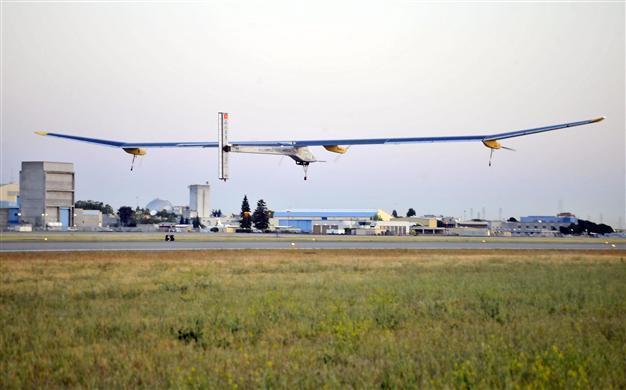Solar plane lands in US Midwest after storms
WASHINGTON - Agence France-Presse

The Solar Impulse plane takes off from Moffett Field NASA Ames Research Center in Mountain View, California in this May 3, 2013 file photo. AFP photo
The Solar Impulse, a single-person solar-powered aircraft piloted by a Swiss adventurer, landed in St. Louis, Missouri early Tuesday on the third leg of a transcontinental flight after over 21 hours in the air.
The organizer's ground crew rushed out on the tarmac of the Lambert-St. Louis International Airport when the aircraft, which has four electric engines and an enormous wingspan, landed at 0627 GMT.
"I feel (like) I was coming back from another world," said pilot Bertrand Piccard upon landing. "It's almost a shock" to return to normal life.
Despite the long hours in the air "I didn't really feel the fatigue. I felt very fortunate to be up there." The landing was broadcast live on the organizer's website, live.solarimpulse.com.
Piccard departed the Dallas-Fort Worth airport in Texas aboard the Solar Impulse at 0906 GMT Monday on the third of a five-stop journey across the United States aimed at showcasing the potential of renewable energy technologies.
St. Louis was chosen as the Midwest stopover to pay homage to aviation pioneer Charles Lindbergh and his "Spirit of St. Louis," the first plane to fly from New York to Paris non-stop.
The Texas-Missouri leg was Piccard's longest flight in the single-seat cockpit to date.
Powerful storms that hit the St. Louis, Missouri area late Friday rendered Solar Impulse's airport hangar unusable, so organizers deployed what they described as "a revolutionary inflatable structure" that would be used "for the first time".
The Solar Impulse project, founded and led by Piccard and another Swiss pilot, Andre Borschberg, aims to showcase what can be accomplished without fossil fuels, and has set as its "ultimate goal" an around-the-world flight in 2015.
The first leg of Solar Impulse's US tour took place on May 3, when Piccard flew the aircraft from the San Francisco, California area to Phoenix.
The US itinerary allows for up to 10 days at each stop in order to showcase the plane's technology to the public. Another stop is planned in the US capital Washington before the trip concludes in New York in early July.
Energy is provided by 12,000 solar cells that power the plane's propellers.
The plane can fly at night by reaching a high elevation of 27,000 feet (8,230 meters) and then gently gliding downward, using almost no power until the sun comes up to begin recharging the solar cells.
